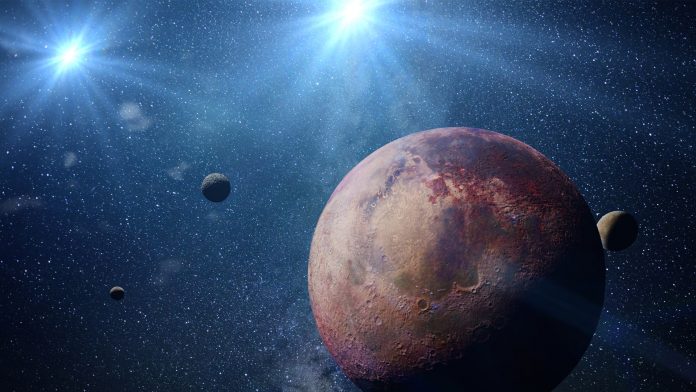A collective of international researchers has identified a novel chemical signature in an exoplanet’s atmosphere for the first time ever.
The team, comprised of researchers from the Astrobiology Center and Queen’s University Belfast, and Trinity College Dublin, detected hydroxyl radical (OH) in an exoplanet’s atmosphere – a planet orbiting a star that is not our Sun – for the first time in history.
The exoplanet home to the OH discovery is WASP-33b – a planet categorised as an “ultra-hot Jupiter”, a giant-gas planet that orbits its host star, reaching atmospheric temperatures more than 2,500° C, capable of melting most metals.
Dr Stevanus Nugroho, the lead researcher at the Astrobiology Center and Queen’s University Belfast, said: “This is the first direct evidence of OH in the atmosphere of a planet beyond the Solar System. It shows not only that astronomers can detect this molecule in exoplanet atmospheres, but also that they can begin to understand the detailed chemistry of this planetary population.”
OH is primarily constructed in the Earth’s atmosphere due to a reaction between water vapour and atomic oxygen; this creates an atmospheric detergent, which plays a vital role in removing life-threatening pollutant gasses from the Earth’s atmosphere.
However, in more colossal planets like WASP-33b, OH interacts with water vapour and carbon monoxide to determine the chemistry of the planet’s atmosphere, with most of WASP-33b’s OH believed to have been produced by high temperatures that destroy said water vapour.
“We see only a tentative and weak signal from water vapour in our data, which would support the idea that water is being destroyed to form hydroxyl in this extreme environment,” explained Dr Ernst de Mooij from Queen’s University Belfast, a co-author on this study.
The researchers enlisted the use of the InfraRed Doppler (IRD) instrument at the 8.2-metre diameter Subaru Telescope, located in Hawaii, to make their discovery – a device proficient in detecting molecules and atoms. IRD achieves this by identifying “spectral fingerprints” – these are distinct sets of dark absorption features superimposed on the rainbow spectrum and emitted by stars and planets.
Throughout the orbit of its host star, the velocity of the planet changes relative to Earth; spectral fingerprints likewise change, allowing the observers to differentiate between the planet and its star, which usually overwhelms most modern telescopes as their infrastructure cannot facilitate hot Jupiter exoplanets.
Dr Neale Gibson, Assistant Professor at Trinity College Dublin and co-author of this work, said: “The science of extrasolar planets is relatively new, and a key goal of modern astronomy is to explore these planets’ atmospheres in detail and eventually to search for Earth-like exoplanets. Every new atmospheric species discovered further improves our understanding of exoplanets and the techniques required to study their atmospheres, taking us closer to this goal.”
The scientists are optimistic that the capabilities of IRD will allow them to make further exoplanet discoveries, potentially analysing colder planets – like our own.
Dr Hajime Kawahara, assistant professor at the University of Tokyo and the co-author of the study, said: “These techniques for atmospheric characterisation of exoplanets are still only applicable to very hot planets, but we would like to develop further instruments and techniques that enable us to apply these methods to cooler planets, and ultimately, to a second Earth.”
Professor Chris Watson, from Queen’s University Belfast, a co-author of the study, added: “While WASP-33b may be a giant planet, these observations are the testbed for the next-generation facilities like the Thirty Meter Telescope and the European Extremely Large Telescope in searching for biosignatures on smaller and potentially rocky worlds, which might provide hints to one of the oldest questions of humankind: ‘Are we alone?’.”









